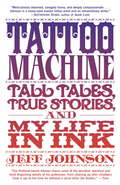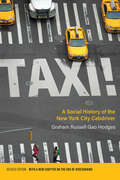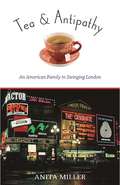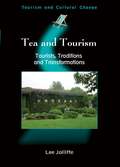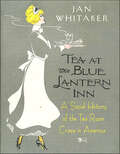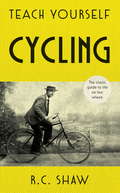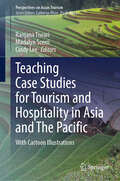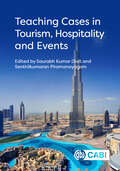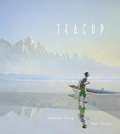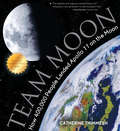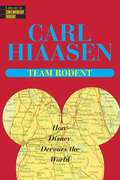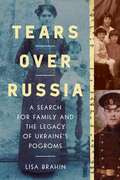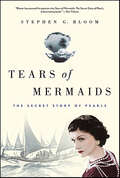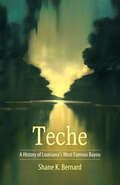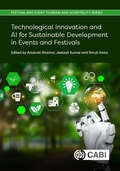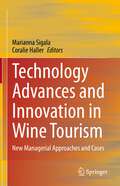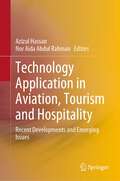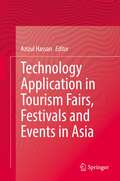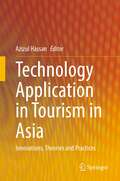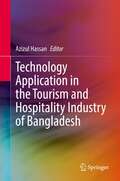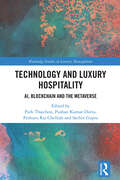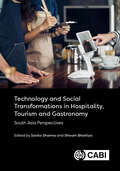- Table View
- List View
Tattoo Machine: Tall Tales, True Stories, and My Life in Ink
by Jeff JohnsonAs the proprietor of the legendary Sea Tramp Tattoo Company, in Portland, Oregon, Jeff Johnson has inked gangbangers, age-defying moms, and sociopaths; he's defused brawls and tended delicate egos. InTattoo Machine,Johnson illuminates a world where art, drama, and commerce come together in highly entertaining theater. A tattoo shop is no longer a den of outcasts and degenerates, but a place where committed and schooled artists who paint on living canvases develop close bonds and bitter rivalries, where tattoo legends and innovators are equally revered, and where the potential for disaster lurks in every corner.
Taxi Driver Wisdom: 20th Anniversary Edition
by Risa Mickenberg“Insights on love, pleasure, fate, and other topics” collected from conversations with New York City cabbies (AM New York).The worse a town’s economy is, the better looking the guys who work at the local gas station are.I see more of what is going on around me because I am not concerned with finding a parking place.There is no chivalry. For that you have to go upstate.Real taxi drivers know more than how to get you there without a GPS—often, they know how to get you there in life. This twentieth anniversary edition of the wise and hilarious classic, as true now as ever, is a celebration of the witty, philosophical perspective on human nature culled from real quotations from real cab drivers who’ve been around the block.
Taxi!: A Social History of the New York City Cabdriver
by Graham Russell HodgesWhy the cabdriver is the real victim of the false promises of Uber and the gig economy.2007 Noteworthy Book in Industrial Relations and Labor Economics, Princeton University Industrial Relations SectionHailed in its first edition as a classic study of New York City's history and people, Graham Russell Gao Hodges's Taxi! is a remarkable evocation of the forgotten history of the taxi driver. This deftly woven narrative captures the spirit of New York City cabdrivers and their hardscrabble struggle to capture a piece of the American dream. From labor unrest and racial strife to ruthless competition and political machinations, Hodges recounts this history through contemporary news accounts, Hollywood films, and the words of the cabbies themselves. A new preface recalls the author's five years of hacking in New York City in the early 1970s, and a new concluding chapter explores the rise of app-based ridesharing services with the arrival of companies like Uber and Lyft. Sharply criticizing the use of the independent contractor model that is the cornerstone of Uber and the gig economy, Hodges argues that the explosion of for-hire vehicles in Manhattan reversed decades of environmental anti-congestion efforts. He calls for a return to the careful regulations that governed taxicabs for decades and provided a modest yet secure living for cabbies. Whether or not you've ever hailed a cab on Broadway, Taxi! provides a fascinating perspective on New York's most colorful emissaries.
Taylor County
by Robert P. RuschWhen Wisconsin became a state in 1848, its densely forested north awaited railroad construction before settlement. Taylor County, the "Garden Spot of Northern Wisconsin," was founded on March 4, 1875. Named for then-governor William R. Taylor, the area was primarily forested with eastern hemlock. The county's portion of the Wisconsin Central Railroad was built in 1873, and station sites were named for suburbs of Boston, including Medford, Charlestown, Chelsea, and Westboro. The county's early years were dominated by lumbering and leather tanning, the latter made possible by tannic acid leached from hemlock bark. By 1900, dairy farms dotted its glacial hills. Today, Taylor County's municipalities are home to diverse industries, ranging from snowshoe manufacturing to America's largest pizza plant.
Tea & Antipathy: An American Family in Swinging London
by Anita MillerTea & Antipathy is a delightfully hilarious and true account of one American family's summer in the posh London neighborhood of Knightsbridge in 1965. Capturing the helpless feeling that living in a foreign city often brings, the book recounts how the Millers met a wide variety of memorable characters from all social classes, including Mrs. Grail the Irish cleaning woman, who was convinced that their home was haunted and who hated the English; Basil Goldbrick, a businessman from Manchester; and Basil's clever wife Daisy, who resented Americans. Told in a gently sardonic tone, this story provides insight on what London was like during the Swinging Sixties and what it was like to uproot a family for an adventurous summer abroad.
Tea and Tourism
by Lee JolliffeThe global production, marketing and consumption of tea present a resource for tea-related tourism. Tea and Tourism: Tourists, Traditions and Transformations profiles tea cultures and examines the social, political and developmental contexts of using related traditions for touristic purposes. This volume views tourism related to tea from differing disciplinary perspectives, and from marketing, planning, entrepreneurial and developmental viewpoints. The book examines the transformation of indigenous and imported tea traditions into experiences for tourists. Profiling these tea experiences from around the world including the United Kingdom; Sri Lanka; India; China; Taiwan; Kenya and Canada the volume reveals the ways in which tea's heritage is adapted for tourism consumption. This is the first definitive work on tea tourism. Global tea tourism trends are identified, while case examples provide fresh perspectives on the ongoing transformation of tea for tourism purposes.
Tea at the Blue Lantern Inn: A Social History of the Tea Room Craze in America
by Jan Whitaker“A delightful tour of the tearooms that dotted the nation in the first half of the twentieth century . . . [an] irresistible slice of American popular culture.” —BooklistThe Gypsy Tea Kettle. Polly’s Cheerio Tea Room. The Mad Hatter. The Blue Lantern Inn. These are just a few of the many tea rooms—most owned and operated by women—that popped up across America at the turn of the last century, and exploded into a full-blown craze by the 1920s. Colorful, cozy, festive, and inviting, these new-fangled eateries offered women a way to celebrate their independence and creativity. Sparked by the Suffragist movement, Prohibition, and the rise of the automobile, tea rooms forever changed the way America eats out, and laid the groundwork for the modern small restaurant and coffee bar.In this lively, well-researched book, Jan Whitaker brings us back to the exciting days when countless American women dreamed of opening their own tea room—and many did. From the Bohemian streets of New York’s Greenwich Village to the high-society tea rooms of Chicago’s poshest hotels, from the Colonial roadside tea houses of New England to the welcoming bungalows of California, the book traces the social, artistic, and culinary changes the tea room helped bring about.Anyone interested in women’s history, the early days of the automobile, the Bohemian lives of artists in Greenwich Village, and the history of food and drink will revel in this spirited, stylish, and intimate slice of America’s past.“The book is both informative and clear-eyed, and leavened with wonderful illustrations.” —House & Garden
Teach Yourself Cycling: The classic guide to life on two wheels
by Reg ShawFirst published in 1953, Teach Yourself Cycling is a beautiful, lovingly reproduced window into a distant age, where understanding the good manners of the road and enjoying the innocence of the family picnic dominated life on two wheels.Yet few vehicles have changed as little as the bicycle in the 65 years since this book first published. For all that they have become immeasurably lighter and better adapted to a range of terrains, the basic mechanics remain the same - and a deeply recognisable spirit of joy runs through this book, even though the author, Reginald Shaw, feels he needs to reassure his readers that cycling can be "a pleasurable activity as well as a mode of transport".This book is perfect for fans of cycling interested in how the art and practice of riding a bike has changed. From a stout defence of 'the good manners of the road' to a surge of enthusiasm when mapping out the itinerary of a good cycling holiday, this book is warm, interesting and enlightening.Since 1938, millions of people have learned to do the things they love with Teach Yourself. Welcome to the how-to guides that changed the modern world.
Teach Yourself Cycling: The classic guide to life on two wheels (Teach Yourself)
by Rc ShawFirst published in 1953, Teach Yourself Cycling is a beautiful, lovingly reproduced window into a distant age, where understanding the good manners of the road and enjoying the innocence of the family picnic dominated life on two wheels.Yet few vehicles have changed as little as the bicycle in the 65 years since this book first published. For all that they have become immeasurably lighter and better adapted to a range of terrains, the basic mechanics remain the same - and a deeply recognisable spirit of joy runs through this book, even though the author, Reginald Shaw, feels he needs to reassure his readers that cycling can be "a pleasurable activity as well as a mode of transport".This book is perfect for fans of cycling interested in how the art and practice of riding a bike has changed. From a stout defence of 'the good manners of the road' to a surge of enthusiasm when mapping out the itinerary of a good cycling holiday, this book is warm, interesting and enlightening.Since 1938, millions of people have learned to do the things they love with Teach Yourself. Welcome to the how-to guides that changed the modern world.
Teaching Case Studies for Tourism and Hospitality in Asia and The Pacific: With Cartoon Illustrations (Perspectives on Asian Tourism)
by Cindy Lee Ranjana Tiwari Madalyn Scerri"Teaching Case Studies for Tourism & Hospitality in Asia and The Pacific – With Cartoon Illustrations" represents a creative contribution to the field of tourism and hospitality education. By combining teaching case studies with cartoon illustrations, this resource aims to stimulate curiosity, encourage intellectual exploration and empower the development of future industry professionals. This book introduces readers to real-life industry case studies and the challenges inherent in the Asia-Pacific region's tourism and hospitality business contexts. It equips students with the knowledge and skills needed to navigate the variety of situations in the industry and provides valuable practical applications for when they enter the workforce. The case studies featured in the book can be used as teaching tools in tertiary tourism and hospitality education. Using the teaching notes, educators are able to stimulate discussions and classroom activities to unpack key themes, ideas, concepts, and theories within the case to facilitate active learning.
Teaching Cases in Tourism, Hospitality and Events
by Andrés Artal-Tur Hugues Seraphin Kalliopi Fouseki Vasantha Lakshmi Professor Maximiliano Korstanje Julia N Albrecht Colin Seymour Dr Binh Nghiem-Phu Alejandra Zuccoli Willem Coetzee Clara Cubillas-Para Delly M. Chatibura Aarti Dangwal Sushant M. Desale Joo-Ee Gan Su Gibson Matt Gnagey Kathryn Hayat Jamie Hoffman Pilar Jiménez-Medina Rohan Jugran Ilias Krystallis Mohit Kukreti Kimberley Camelia Langstieh Rachel Hyunkyung Lee Tiffany S. Legendre Sarat Kumar Lenka Kamakshi Maheshwari Drew Martin Miguel Mayol-Tur Amitabh Mishra Snigdha Mishra Cass Morgan Nametsegang Motshegwa Selvalakshmi Muthuvelu Preeti Narendra José Miguel Navarro-Azorín Naresh P Nayak Evarisa M. Nengnong Maria Isabel Osorio-Caballero Kabila Ramanathan Dr Senthilkumaran Piramanaygam Andrea Salustri Shwetasaibal Samanta Sahoo Noelia Sánchez-Casado Kader Sanliöz-Özgen Abhijeet Shirsat Chandradeep Singh Hang T.B. Tran Ranjana Tiwari Alan Vijay V. J. SivakumarThe tourism, hospitality and events industries comprise one of the largest and most diverse workforces in the world, creating high demand for graduates with strong technical and managerial competencies. Case-based learning encourages students to think, understand, and apply the concepts and theories they're taught into practical, everyday situations faced in the world of work. Providing a broad selection of extensive global cases, this book forms a comprehensive one-stop-shop resource for readers to test their analytical skill and abilities in solving complex management issues. Cases include teaching notes to reflect theoretical perspectives, as well as questions, detailed learning activities and solutions. The book covers: - General management, including innovation, ethics, and sustainability; - Strategic management, including business models, SWOT analyses and internationalisation; - Human resource management, including motivating employees, conflict management and work-life balance; - Marketing, including managing service quality, branding and new service development; - Financial management, including budgeting, risk management and forecasting; - Operations management, including food and beverage delivery, revenue management and health and safety. A useful and engaging read for students of tourism, hospitality and events, this book is also a valuable compilation of examples of practice for people working in industry.
Team Moon: How 400,000 People Landed Apollo 11 on the Moon
by Catherine Thimmesh&“This behind-the-scenes look at the first Apollo moon landing has the feel of a public television documentary in its breadth and detail&” (Publishers Weekly, starred review). Here is a rare perspective on a story we only thought we knew. For Apollo 11, the first moon landing, is a story that belongs to many, not just the few and famous. It belongs to the seamstress who put together twenty-two layers of fabric for each space suit. To the engineers who created a special heat shield to protect the capsule during its fiery reentry. It belongs to the flight directors, camera designers, software experts, suit testers, telescope crew, aerospace technicians, photo developers, engineers, and navigators. Gathering direct quotes from some of these folks who worked behind the scenes, Catherine Thimmesh reveals their very human worries and concerns. Culling NASA transcripts, national archives, and stunning NASA photos from Apollo 11, she captures not only the sheer magnitude of this feat but also the dedication, ingenuity, and perseverance of the greatest team ever—the team that worked to first put man on that great gray rock in the sky. Winner of the Robert F. Sibert Informational Book Award &“An edge-of-your-seat adventure . . . Lavishly illustrated . . . This exhilarating book . . . will captivate.&” —Chicago Sun-Times &“Thimmesh gives names and voices to the army that got Neil Armstrong and company to the moon and back. The result is a spectacular and highly original addition to the literature of space exploration.&” —The Horn Book &“This beautiful and well-documented tribute will introduce a new generation to that triumphant time.&” —Kirkus Reviews (starred review)
Team Rodent: How Disney Devours the World
by Carl Hiaasen"Disney is so good at being good that it manifests an evil; so uniformly efficient and courteous, so dependably clean and conscientious, so unfailingly entertaining that it's unreal, and therefore is an agent of pure wickedness. . . . Disney isn't in the business of exploiting Nature so much as striving to improve upon it, constantly fine-tuning God's work."--from TEAM RODENTTEAM RODENTHow Disney Devours America"Revulsion is good. Revulsion is healthy. Each of us has limits, unarticulated boundaries of taste and tolerance, and sometimes we forget where they are. Peep Land is here to remind us; a fixed compass point by which we can govern our private behavior. Because being grossed out is essential to the human experience; without a perceived depravity, we'd have nothing against which to gauge the advance or decline of culture; our art, our music, our cinema, our books. Without sleaze, the yardstick shrinks at both ends. Team Rodent doesn't believe in sleaze, however, nor in old-fashioned revulsion. Square in the middle is where it wants us all to be, dependable consumers with predictable attitudes. The message, never stated but avuncularly implied, is that America's values ought to reflect those of the Walt Disney Company, and not the other way around."From the Trade Paperback edition.
Tears Over Russia: A Search for Family and the Legacy of Ukraine's Pogroms
by Lisa BrahinA sweeping saga of a family and community fighting for survival against the ravages of history.Set between events depicted in Fiddler on the Roof and Schindler&’s List, Lisa Brahin&’s Tears over Russia brings to life a piece of Jewish history that has never before been told. Between 1917 and 1921, twenty years before the Holocaust began, an estimated 100,000 to 250,000 Jews were murdered in anti-Jewish pogroms across the Ukraine. Lisa grew up transfixed by her grandmother Channa&’s stories about her family being forced to flee their hometown of Stavishche, as armies and bandit groups raided village after village, killing Jewish residents. Channa described a perilous three-year journey through Russia and Romania, led at first by a gallant American who had snuck into the Ukraine to save his immediate family and ended up leading an exodus of nearly eighty to safety. With almost no published sources to validate her grandmother&’s tales, Lisa embarked on her incredible journey to tell Channa&’s story, forging connections with archivists around the world to find elusive documents to fill in the gaps of what happened in Stavishche. She also tapped into connections closer to home, gathering testimonies from her grandmother&’s relatives, childhood friends and neighbors. The result is a moving historical family narrative that speaks to universal human themes—the resilience and hope of ordinary people surviving the ravages of history and human cruelty. With the growing passage of time, it is unlikely that we will see another family saga emerge so richly detailing this forgotten time period. Tears Over Russia eloquently proves that true life is sometimes more compelling than fiction.
Tears of Mermaids: The Secret Story of Pearls
by Stephen G. BloomA round, luminescent pearl is the simplest and most perfect gem. Columbus sought—and found—this precious jewel coveted by his Spanish sovereigns, sparking popularity throughout Europe. Fashion icons Jacqueline Kennedy, Princess Grace, and Michelle Obama cherished them, making them iconic. And designer Coco Chanel raised them to new heights, bringing pearls— fake and real—to women everywhere. In Tears of Mermaids, Stephen G. Bloom travels 30,000 miles in an effort to trace a single pearl—from the moment a diver off the coast of Australia scoops an oyster containing a single luminescent pearl from the ocean floor to the instant a woman fastens the clasp of a strand containing the same orb. Bloom chronicles the never-before-told saga of the global pearl trade by gaining access to clandestine outposts in China, the Philippines, French Polynesia and Australia. He infiltrates high-tech pearl farms guarded by gun-toting sentries, farms for pearls in rural China, and even goes backstage at Christie's for a fast and furious auction of the most expensive pearl ever sold. Teeming with rogue humor and uncanny intelligence, Tears of Mermaids weaves a nonstop detective story whose main character is the world's most enduring jewel.
Teche: A History of Louisiana's Most Famous Bayou (America's Third Coast Series)
by Shane K. BernardRecipient of a 2017 Book of the Year Award presented by the Louisiana Endowment for the HumanitiesShane K. Bernard's Teche examines this legendary waterway of the American Deep South. Bernard delves into the bayou's geologic formation as a vestige of the Mississippi and Red Rivers, its prehistoric Native American occupation, and its colonial settlement by French, Spanish, and, eventually, Anglo-American pioneers. He surveys the coming of indigo, cotton, and sugar; steam-powered sugar mills and riverboats; and the brutal institution of slavery. He also examines the impact of the Civil War on the Teche, depicting the running battles up and down the bayou and the sporadic gunboat duels, when ironclads clashed in the narrow confines of the dark, sluggish river.Describing the misery of the postbellum era, Bernard reveals how epic floods, yellow fever, racial violence, and widespread poverty disrupted the lives of those who resided under the sprawling, moss-draped live oaks lining the Teche's banks. Further, he chronicles the slow decline of the bayou, as the coming of the railroad, automobiles, and highways reduced its value as a means of travel. Finally, he considers modern efforts to redesign the Teche using dams, locks, levees, and other water-control measures. He examines the recent push to clean and revitalize the bayou after years of desecration by litter, pollutants, and invasive species. Illustrated with historic images and numerous maps, this book will be required reading for anyone seeking the colorful history of Louisiana and the Gulf Coast.As a bonus, the second part of the book describes Bernard's own canoe journey down the Teche's 125-mile course. This modern personal account from the field reveals the current state of the bayou and the remarkable people who still live along its banks.
Technological Innovation and AI for Sustainable Development in Events and Festivals (Festival and Event Tourism and Hospitality Series)
by Anukrati Sharma Jeetesh Kumar Shruti AroraFrom sustainable event planning to the influence of VR, AI, and mobile applications on tourist behaviour, this book explores the dynamic landscape where innovation meets tradition. It studies the intersection of green technologies, sustainable infrastructure, and the delicate balance between cutting-edge tools and the intrinsic emotional aspects of human engagement. Aligned with the United Nations' 17 Sustainable Development Goals, the book highlights AI's potential to drive meaningful contributions to a sustainable future. It anticipates the imminent transformation of festivals and events through technological innovation and AI implementation. It will allow the reader to gain insights into how automation streamlines logistics, optimizes marketing efforts, and enhances the overall attendee experience. The book offers readers: · A cutting-edge exploration of the transformative impact of technologies and artificial intelligence on the events and tourism industries. · Oversight of how new technology can align with the United Nations' 17 Sustainable Development Goals - readers can anticipate insights into how AI can contribute meaningfully to understanding and addressing pressing global challenges. · Practical insights for stakeholders including actionable insights that go beyond theory. It will be an essential reference for academic researchers and practitioners within events and tourism management.
Technology Advances and Innovation in Wine Tourism: New Managerial Approaches and Cases
by Marianna Sigala Coralie HallerThis book consolidates under one roof the latest research investigating the various technological advances and new managerial approaches driving innovation within wine tourism. Competition in wine tourism intensifies at a global scale, while wine tourism demand continuously evolves, diversifies and becomes more sophisticated. The book highlights that innovation and technology exploitation have become not only a way to differentiate but also a survival necessity for wine tourism operators and wine destinations alike.This book includes cutting edge research about the latest technological developments and advances that revolutionise the wine tourism sector and transform the way wine tourism experiences are designed and delivered. In addition, the book includes case studies and research findings showing how wine tourism operators and destinations can nurture, support and implement innovation at various levels, including the experience, the process, the business model and/or the ecosystem level.
Technology Application in Aviation, Tourism and Hospitality: Recent Developments and Emerging Issues
by Azizul Hassan Nor Aida Abdul RahmanThis book covers multiple areas such as technology and the type of application in aviation, tourism and hospitality with looking at current and future technology application, as well as in a rural tourism perspective. The strength of this book comes from the authors themselves coming from multiple higher institutions in Malaysia and Indonesia as these two countries are the top two countries in Southeast Asia with the world's most popular tourist destinations and for a reason: a tropical climate, rich culture, gorgeous beaches, wonderful food and low prices. This book is also packed with detailed knowledge in the area of air travel, as well as deep understanding on the related theories used as theoretical underpin in performing air travel research. This book provides insightful discussion and very beneficial to the reader. This book is suitable for the following readers: general, students, travelers, academics, tourism consultants, aviation regulators, aviation practitioners and ministries of tourism. Readers are also exposed to recent issues and development pertaining technology application in aviation tourism and hospitality, theoretical discussion related to technology application as well as its application and future research application.
Technology Application in Tourism Fairs, Festivals and Events in Asia
by Azizul HassanIt is an unconditional reality that the tourism industry in Asia is becoming exposed to innovative technologies more than ever before. This book reports the latest research in the application of innovative technology to the tourism industry, covering the perspectives, innovativeness, theories, issues, complexities, opportunities and challenges affecting tourism in Asia. A blend of comprehensive and extensive efforts by the contributors and editors, it is designed especially to cover technology applications in tourism fairs, festivals and events in Asia. The application and practice of technologies in tourism, including the relevant niches of fairs, festivals and events are also covered, with a focus on the importance of technology in tourism. This book highlights, in a comprehensive manner, technologies that are impacting the tourism industry in Asia, as well as the constraints it is facing. It deals with distinct topics, such as tourism promotion, technology-driven sustainable tourism development, social media, accessibility and so on to cover fairs, festivals and events. This book is a significant contribution towards the very limited knowledge in this identified research area, with examples from selected Asian countries. This book is designed to accommodate both qualitative and quantitative research linking theory and practice. This book has a clear focus on outlining the research issues. Each chapter of the book highlights a methodology that was used, with rationale for its use. This book addresses a number of revisions that unify the theme or framework to integrate the chapters.
Technology Application in Tourism in Asia: Innovations, Theories and Practices
by Azizul HassanThis book very specifically focuses on technology application in tourism in Asia. The book contains twenty-seven chapters in four sections (i.e., theories, innovations, practices, and future research directions), based on the intriguing qualities and importance of technology applications in the Asian tourism business. This book, a blend of comprehensive and extensive efforts by the contributors and editor, is designed to extensively cover technology applications in tourism in Asia, including distinct topics such as mobile computing, new product designs, innovative technology usages in tourism promotion, technology-driven sustainable tourism development, location-based apps, mobility, accessibility, the post crisis situation of COVID-19, etc. This book is a significant contribution towards the very limited knowledge of technology applications in tourism, with selected examples of Asian countries. The importance of technology in Asian tourism is rapidly increasing, and has led to a rise in luxury, allowing citizens to enjoy leisure travel over both long and short distances. The rise of low-cost airlines and the region’s growing, affluent middle class have changed the tourism environment dramatically. More tourists are booking their holidays online as a result of technological advancements. Online travel is the most important and well-established aspect of Asia's Internet economy. Considering the ongoing trend of technology applications in the tourism industry in Asia, more research attempts like this book need to be made aiming towards exploring diverse aspects. As tourism is an expanding area, this book can serve as a reading companion for tourism students, policy planners and industry professionals. This book is expected to be appreciated by expatriate researchers and researchers having a keen interest in the Asian tourism industry.
Technology Application in the Tourism and Hospitality Industry of Bangladesh
by Azizul HassanThe tourism and hospitality industry of Bangladesh as a South Asian country has potential. Sustainable development of this industry in this country is on the move. Still, there are some hindrances which appear to be stymieing this industry’s overall development potential. Overcoming such hindrances can be partly enabled by applying digital innovation and introducing more Internet based platforms in the country’s tourism and hospitality industry. The country is believed to have emphasized innovative technology application in this industry, but technology applications in this industry in Bangladesh have so far attracted very few researchers, resulting in insufficient contributions and very limited knowledge.This book, therefore, can make a significant contribution towards the very limited knowledge in this identified research area. On the specific ground of technology application in the tourism and hospitality industry, the book covers concepts and context, the present scenario, product and service offers, and an analysis of the roles of public and private institutions. On related issues, the book also covers social media, networking and connectivity; sustainability practices and climate change effects; tourist experiences; developments; and challenges, suggestions, and future research directions. The book is expected to appeal to general readers, as well as researchers with an interest in technology applications in the tourism and hospitality industry. This book is also an essential read for the relevant policy planners and industry professionals.
Technology and Luxury Hospitality: AI, Blockchain and the Metaverse (Routledge Studies in Luxury Management)
by Pethuru Raj Chelliah Park Thaichon Sachin Gupta Pushan Kumar DuttaThe integration of pioneering information and communication technologies has transformed the hospitality sector. This groundbreaking book delves into the transformative power of cutting-edge technologies in the world of high-end travel and accommodation. As the digital revolution continues to reshape our lives, this book offers an exclusive look at how the hospitality industry is adapting and evolving to cater to the sophisticated tastes of the modern, tech-savvy traveller.In this eye-opening exploration, readers will be taken on a journey through the latest innovations in artificial intelligence, blockchain, and the metaverse as they intersect with the world of luxury hospitality. From AI-driven concierge services and smart hotel rooms that cater to guests' every whim to the democratization of luxury experiences through blockchain-based loyalty programmes and the rise of virtual reality travel, this book reveals the extraordinary possibilities that lie ahead for the discerning traveller.With insights from international experts, this edited collection provides a comprehensive and engaging overview of the current and future trends shaping the industry and will be valuable to scholars and postgraduate researchers across the hospitality sector, innovation, and luxury management.
Technology and Social Transformations in Hospitality, Tourism and Gastronomy: South Asia Perspectives
by Amit Kumar Sanjeev Kumar Amandeep Khurana Omar Abdullah Kamlesh Attri Vaibhav Bhatt Sonali Chhetri R K Dhodi Rashmi Dhodi Afsheen Hassan Fatemeh Shah Hosseini Suneel Kumar Varinder Kumar Rekha Maitra Zahra Nadalipour Teena Pareek Bindu Roy Dilraj Singh Shadev Sidharth Srivastava Tahir Sufi Kuldeep VermaThis book explores the relationship between technology and social transformation in tourism, hospitality and gastronomy. It presents research and case studies, elaborating on benchmark practices adopted by tourism and hospitality professionals. In recent years, technology has transformed the tourism and hospitality industry; the chapters in this book cover areas such as guest experience and service quality, as well as operational areas such as housekeeping and waste management. Further social transformation in tourism is a result of drivers such as a growing interest in gastronomy and the use of social media; this is covered in the first part of the book. The second part outlines how communities may learn from these events. With contributions from academics, entrepreneurs, destination managers and government officials from the South Asia region, this book offers a real insight in to these areas of growing interest and provide a useful resource for those researching and studying within the areas of tourism development and hospitality.
